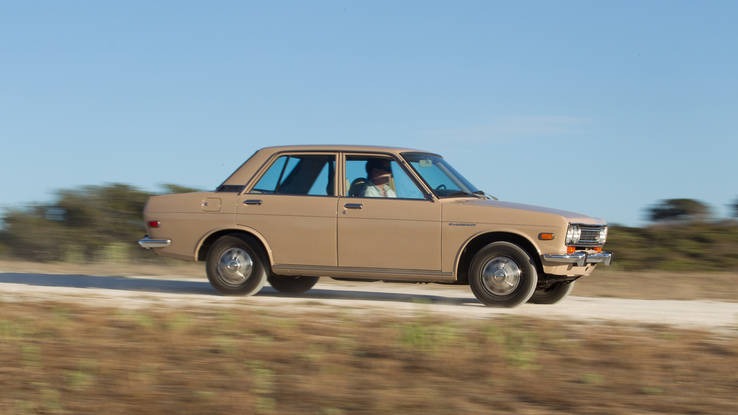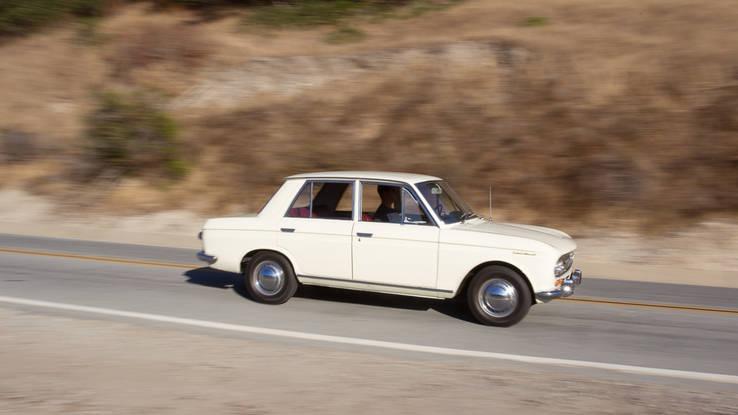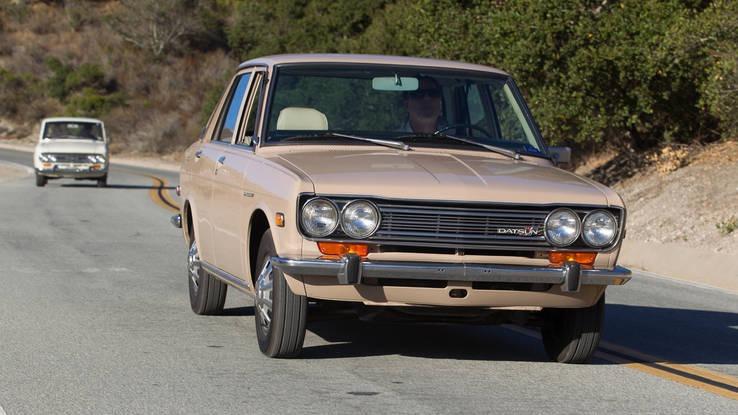Four hundred miles in two different icons
I finally got to drive the automotive icon I’d always dreamed about driving. And another one I hadn’t dreamed about at all.
Before the experience I’m about to relate, I’m ashamed to say I had never driven a Datsun 510. I had tried many times to weasel my way behind the wheel. I once, 20 years ago, cut a vacation short to attend a meeting of a group that might have been called the Five and Dime Club(?) in the parking lot of TRW Space Systems in Redondo Beach or El Segundo or someplace like that. Not only did the meeting never materialize (or at least I never found it), but I almost got arrested as a Russian spy. It would have been worth it, I told myself. Because I knew the 510 was an icon of practical performance.
I knew this even though I’d never driven one. Sometimes you just know, or assume, these things. It was all there on the spec sheet: the 510 was a two-, four- or five-door four-seater with a useable trunk but it had the engine in front driving the rear wheels. It was a formula I believed made up the perfect car. Whenever I sat next to an influential auto exec who drew the short straw at dinner, I used it as an example of automotive perfection that must be brought back to life. “Of course there’d be a market for it, it’s just that the market doesn’t realize yet how much it’d love a car like that!” Sometimes the execs went as far as drawing diagrams on napkins explaining why it would never work. Sometimes they just smiled. A few smirked. Maybe someone at Subaru or Scion listened and made the almost-perfect BRZ/FR-S. Who knows?

The Datsun 510 was sporty for it’s era, but less so by later standards. At least in stock form.
The Datsun 411, meanwhile, played a lesser role in the race track that ran through my imagination. A 411 was the predecessor to the 510 and shared the same front-engine rear-wheel-drive configuration. Its body was designed by Pininfarina. It was stylish as well as well-balanced. But the 411 was never played up in automotive sports sedan iconography the way the 510 was. In high school a friend had a 411 that he referred to as “The g**d***** car,” and the GD didn’t stand for Great Driver. We once spent a day trying to retrieve a bolt that he dropped into the intake manifold when we had the carb off. I can still hear tink-tink-plink as it worked its way toward the cylinders. My idea was to roll the car upside down and shake it till the bolt came out. I think he wound up removing the intake manifold. But let’s not get off topic.
So when Nissan called and offered to let me and two car-media colleagues drive both cars all the way from LA to Monterey for the Pebble festivities, I dropped the luxury resort hotel accommodations that had been extended by a different automaker and gladly accepted the fleabag hell-hole hotel offered by Datsun, the Yelp reviews of which promised surly staff and bloody sheets. This was a 510, after all, and when you get a chance to drive a 510 you take it.
The idea proffered by Datsun/Nissan was to show the lineage, the driveshaft-straight line, from these two ancients directly to the modern and mighty Maxima. That’s what they said. It was a little like tracing the Ford GT prototype to the Model T. They both had Ts in their names and relied on internal combustion, but beyond that… aw who cares? I was willing to agree to just about any whack philosophy if it meant finally getting behind the wheel of a real 510.

Datsun 411
And then I was. Not just any 510 but what might be the last one extant that hadn’t been lowered, chopped and engine-swapped. Almost every remaining 510 on the planet has been aftermarketed to death, with the best and worst ideas of every owner it’s ever had. But not this one. Two years ago Nissan was approached by the son of the original owner of a 1972 510 four-door sedan that had lived its entire life and driven all of its 55,000 original miles in Pennsylvania.
“It was really difficult for us to find one that hadn’t been slammed and modded-out,” said Nissan product planner Jonathan Buhler, a lifelong Datsun fan who owns 240Zs and is currently living his dream job.
Even more amazing, in this age of ever-rising collector car prices, they got this example for just $ 7400. It was in excellent shape. All they had to do was repaint it in the original Bamboo Tan, put in new struts, rebuild the carb, fix a couple of tears in the seats, “…and that was it,” said Buhler.
As the sun popped up over LA with a loud sploot, I crawled into the 510 and fired the 1595cc sohc Hitachi downdraft-carburetted engine. It started with no pumping the gas pedal nor even tugging on the manual choke. The throws in the transmission were by my estimate about 400 to 500 feet long, with first-to-second taking about a mile. But at least the shifter was vague. The steering wheel was as skinny as a runway model’s middle finger. And the acceleration? You would use the word, “eventually” in any description of 0-60, which was listed on a spec sheet we were given as 14.5 seconds.
But now it was mine, for a couple hundred miles, anyway. I jumped in the 510 first because you never know how long these cars will last on these trips and I didn’t want to miss out on the opportunity should the unthinkable happen and the car putz-out with some unfixable catastrophe. I engaged the clutch, eased onto the gas and… off… it… went… slowly. Oh it was slow. The spec sheet listed 96 hp at 3600 rpm, which should have motivated the 2015-pound car a little quicker than this, I thought.
Rounding corners it lay over on its side like a happy Japanese dog that wanted its belly rubbed. Braking also occurred, via discs in front and drums in back.
Wait a second, I thought. This is the performance icon I had longed for all my life?

Datsun 510 leads 411
Maybe stock isn’t the way to go. Maybe there’s a reason everyone modded the heck out of these. In performance trim, say with one of Pete Brock’s lauded Mulholland kits or in full BRE race readiness, the 510 could beat the best cars in the world. It did beat them in Trans-Am 2.5 in 1971-72 with the great John Morton driving. And the car remains a favorite of club racers all over the world. Just not in stock form like this one.
Next I got into the 411. This one was a 1967 four-door sedan with the same displacement four-cylinder but with push rod-operated overhead valves. With a curb weight of 2102 pounds, it got to 60 mph in 17 seconds and did the quarter mile in 21.4 at 65 mph, according to the spec sheet I got, which quoted the May, 1967 issue of Car and Driver. With a three-speed automatic it might have seemed less engaging to drive but by clicking the gear selector into low we found it could be semi-responsive. Compared to the 510, however, it was smaller, wheezier and leaned over even more, making it less thrilling than the 510.
But that was only at first. After a while you forget your expectations and start to appreciate the car for what it is. Like a long-term relationship, you stop looking for what you expected and start enjoying what’s there. And then it becomes kind of fun, in an automotively historic fashion. Compared to the luxo-tuna boats that were on the market back in the 1960s and early ‘70s these were probably pretty fun, and they’re still fun 48 years later. And I still think modern car companies should make something like this today.
Yes, the big boat Maxima also turned out to be a fine sedan and you should drive one before buying anything else in that class, but Nissan, why not make something small, relatively inexpensive, practical and fun? Front engine, rear-drive, two rows of seats and a useable trunk? How about a BRZ/FR-S with a more practical body? Why not a Nissan IDx?





























